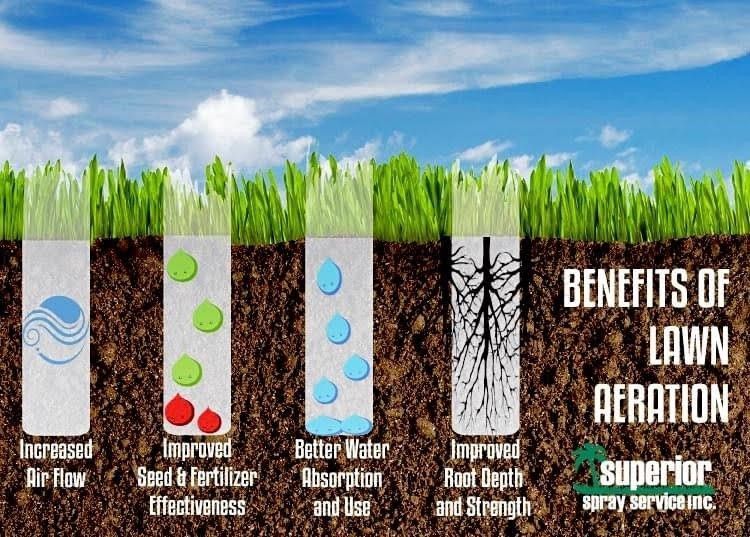Aeration

Aerating your lawn does all the following and more:
- Reduces your dependency on water. Why spend more money watering your lawn than you have to? In neighborhoods or cities where water is very expensive, nearly everyone will aerate their lawn.
- Aerating encourages your roots to grow deeper. Within two weeks of aerating, you'll notice that the holes left by the aerator start to fill up with plant roots. These roots are growing thicker and deeper.
- Lawn Aerator holes help to absorb water. Rather than water having to start penetrating from the surface, it can start penetrating from one to 2 ½ inches below the surface. Not only will the holes made by the aerator hold the water, but they will also help the water to sink 2 inches deeper into the soil.
- It also encourages thicker turf. As your roots grow down, your grass will grow quicker and thicker, creating a thicker turf.
- Using a lawn aerator helps build organic material in the soil. Compacted soil just doesn't have nearly as much organic material in it.
- Reduces soil compaction. Aerating also reduces compaction on the roots.
- Your lawn stays greener because it doesn't need as much water to stay green, and because deeper roots have more access to nutrients.
- Aerating your lawn helps out with over seeding it. It makes it a lot easier to seed your lawn if you have holes for the seeds to fall into, and you have plugs on the surface to help them germinate.
- Aerating adds a layer of top-dressing to your lawn. Yeah! Aerating your lawn is like giving it top-dressing. This reason alone makes me want to aerate my lawn twice a year.
- Aerating makes your lawn more durable and resistant to foot traffic. This is one of the most important reasons why they zealously aerate lawns on golf courses, especially on the putting greens and tip-off/driving areas where they get the most traffic.
- Aerating allows air direct access to the plant. Air exchange can take place more readily, and it can help your plants be more healthy.
- Lawn aeration helps aerobic bacteria to break down thatch in your lawn. It does this because it allows aerobic bacteria access to the thatch layer.
- Using a lawn aerator regularly can help reduce thatch by helping your roots to grow down into the ground and not along the surface. Superficial root growth creates thatch. Once aerated, roots grow down, and thatch isn't much of an issue.
- Lawn aeration reduces runoff. If you've ever watered your lawn, only to see it all go off into the street, you know exactly what I'm talking about. When you aerate your lawn, the water goes into the ground and not just over the top of it.
- Using aerators for lawns, can help to turn the soil for you. You can't exactly till your soil up without destroying all your grass, but you can turn the soil when you aerate it.
- When you aerate lawn, you pull up beneficial bacteria from under the soil that can help break down thatch that is on top of the surface of the soil.
- Lawn aeration can prevent compaction. Clay soils tend get more compacted, especially during the summer, or when average daily temperatures go above 75°. Lawn aeration can prevent this compaction from damaging your root system.
- It makes it a lot easier for fertilizers to work their way into the soil. Also, if you plan on covering your grass with a light layer of top-dressing, you will have the best results if you aerate it before hand.
- You should also aerate your ground before putting down new sod. It will help it to come in a lot faster.
- Aerating increases the effectiveness of fertilizers. Fertilizing right after you aerate your lawn is the best way for you to get good penetration. This allows the fertilizer to go where it needs to go, and not just sitting on the surface of your grass.
- Lawn aeration, as the name implies, makes it easier for your lawn to breathe. Your lawn can more readily exchange oxygen and carbon dioxide with the environment when you aerate it.
- Lawn aeration will increase activity levels of microorganisms in your soil because it will make it easier for your soil to keep moisture, and absorb it at a deeper level.
- It helps to prevent lawn disease. When water sits on top of your lawn for long periods of time, it can easily develop a lawn disease or fungus. When you aerate, you make it easier for water to penetrate and not just sit on top of the surface of the soil, and this reduces the chances of getting lawn disease.
- Aerating makes your grass more resistance to drought.
- Using a lawn aerator makes your grass more tolerant of high temperatures.
Disclaimer:
This page is purely for informational purposes and we do not offer lawn aeration services.

